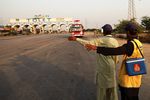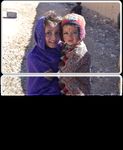Engaging Adolescents and Children - The Communication ...
←
→
Page content transcription
If your browser does not render page correctly, please read the page content below
Learning Briefs – Pakistan Polio Communication February 2021
Engaging Adolescents and Children
Learning Brief 6
CONTEXT
In several countries, the polio programme has
successfully used the strategy of engaging
adolescents and children in high-risk
communities. This approach has proven to be a
positive way to sensitise teachers and
schoolmasters and to introduce curricula
covering a range of health practises – from
vaccination to personal hygiene. It has been
used to engage young people in positive
community action, to catalyse the formation of
youth groups, and to involve older siblings in Bottlenecks and Gaps
polio vaccination campaigns through activities The volume of misinformation in circulation, as well as reports, for example, of
that raise the profile of immunisation days, children spitting out oral polio vaccine (OPV) because they have been told to
attract or bring young children to vaccination fear it, tell us there will be some resistance. Some schools have been at the centre
points, and increase community support for of anti-polio vaccination rumours and misinformation. The different approaches
polio vaccination. and educational focus of public schools versus madrassas mean the tools and
approaches would need to be tailored to each. In addition, youth groups
Given the growing mistrust in Pakistan’s polio
themselves represent new partner groups that would need to be mapped, with
programme amongst high-risk and vulnerable
relationships built.
communities leading to increases in refusals,
not available (NA) children, and harassment of Not all parents will support this type of initiative, especially amongst the most
polio frontline workers (FLWs), initiatives that vulnerable and highest-risk communities, where there are frequent reports of
inform and engage adolescents and children in parents colluding with or intimidating FLWs to finger-mark children without
healthy behaviours and encourage them to vaccinating them or mark them down as vaccinated when they are not. Equally,
promote these behaviours in their homes and there is a history of the polio programme attempting to gain access to schools
communities could be a useful tool for changing and madrassas through Imams, but there is also a history of parents, teachers,
and sustaining attitudes to vaccination. and schoolmasters refusing access and/or difficulties getting permission slips
signed for in school immunisation. Ensuring youth safety in areas where
concerned parents sometimes hide children, and where entire communities
refuse polio vaccination because the programme has used coercive methods or
because they feel they can leverage withholding participation in the programme
to get access to other services, will be a significant concern.
However, this is an approach that has been used with considerable success in
other endemic countries and has the potential to: mobilise and inform the next
generation of parents on the importance of vaccination and other healthy
behaviours, create opportunities for more informed family discussions about
vaccination, reduce fear amongst younger children based on their older siblings’
opinions, and generate more community support, as local adolescents engage in
public activities to raise the profiles of immunisation days and attract children to
get vaccinated.Learning Briefs – Pakistan Polio Communication February 2021
Lessons: Nigeria
In Kaduna State, Northern Nigeria, the polio programme was facing serious
challenges, with persistent refusal of OPV and harassment of vaccination team
members by youth. To address these problems, an intervention was introduced
to engage young people from several OPV-refusing communities. The young
people were drawn from existing youth groups and worked in collaboration
with traditional leaders. Relevant information, education, and communication
(IEC) and sensitisation materials were developed, and 1-day workshops were
conducted with the youth, using lecture, discussion, and role play.
During the polio campaign, the sensitised youth were deployed to areas of
noncompliance and vaccination team harassment. The youth worked with
vaccination teams for 7-8 days carrying and distributing "pluses" (such as sugar
and milk sachets), helping with crowd control at health camps, and providing
entertainment. After each campaign, data were collated and analysed and
debriefing sessions were organised with the youth and traditional leaders.
“systematic engagement
The research concludes that ”systematic engagement of youth groups has a of youth groups has a
great future in polio interruption as we approach the endgame. It promises to
be a veritable innovation in reaching chronically missed children in OPV- great future in polio
refusing communities in Nigeria and other polio-endemic countries.” interruption as we
The evaluation found that in one local government area (LGA), the proportion approach the endgame.
of missed children fell from 7% to 2%, and non-compliant households fell from … promises to be a
4,126 to 778. In another LGA, the proportion of missed children decreased
from 5% to 1%. There was a significant decline in missed children, and team
veritable innovation …”
harassment decreased from >10 incidents toLearning Briefs – Pakistan Polio Communication February 2021
Lessons: India
India’s Pulse Polio Programme engaged older children to
extend their reach in the communities, act as “messengers
of change”, and encourage parents to vaccinate their
younger siblings. The goal was to provide a colourful and
effective way to increase coverage and educate the next
generation, instilling a spirit of community service that was
later tapped into to address other child health problems. “… called out to mothers,
The strategy involved partnering with local schools and
waved flags, beat drums,
madrassas to engage teachers and students in the polio sang songs, and shouted
effort. Before each polio campaign, polio mobilisation staff slogans …urged to share
conducted a "polio class", where primary and middle-
school children learned about polio transmission and its information with families
link with sanitation. Over time, these sessions were and neighbours ..”
modified to incorporate more enjoyable activities, using
entertainment formats like colouring books and games to
prompt discussion of polio, immunisation, and water, Ways Forward
sanitation, and hygiene (WASH). These classes came to be
known as "Masti ki Kaksha", or fun classes, and were There are plans for a formative research project with a
conducted once a month, whether the polio campaign was subsequent intervention component conducted as a pilot study
being held or not. The children were urged to share the in union council (UC) Landhi-1 in Karachi and led by
information with their families and neighbours and to UNICEF’s health section. Its objective is to better understand
encourage them to maintain good health and hygiene. how adolescents can be engaged to increase the uptake of
essential immunisation (EI) in their families and communities
The children also participated in announcing campaigns by and to shift the attitudes and decisions of vaccine-hesitant
marching through the streets to create a celebratory
caregivers. As this work unfolds, the following points are
atmosphere and generate interest. They called out to
mothers, waved flags, beat drums, sang songs, and shouted important for the polio programme to consider:
slogans about immunisation to summon caregivers and
• Engaging adolescents needs to be seen as a long-term
children to the immunisation booths. Children were seen to
be effective ambassadors for change, as they were investment in the future, offering the next generation of parents
enthusiastic and perceived by the community as non- a better understanding of healthy behaviours, the importance of
threatening. Over time, the polio rally was transformed to vaccination, and the value of giving back to their communities.
promote not only immunisation but also good WASH
practises. • In the short term, this strategy can begin to be
introduced through targeted media campaigns including social
Qualitative evidence shows that the knowledge children media, working with willing schools/madrassas to develop
gained from the programme was passed on to the family acceptable educational resources, identifying teachers or other
and had an impact on health-related behaviour; for appropriate influencers to use these resources, mapping and
example, a father of a child participant of the Kukuru-ku engaging existing youth groups and civil society organisations
rally said, "My children tell me that we must wash our (CSOs), and identifying appropriate celebrities/ambassadors.
hands with soap after defecation. I happily obey their
instructions." • Both short- and long-term strategies can have a
positive impact on polio-related public attitudes through
household dialogue, sibling communication, influencer
engagement, and visible community action.
• Working with this age group provides an opportunity
to open new channels of communication with caregivers,
younger siblings, teachers, religious/traditional leaders, and
local communities
3Learning Briefs – Pakistan Polio Communication February 2021
Ways Forward continued
• There is potential to raise the profile of campaigns and
contextualise discussion of polio vaccination with EI and related
health behaviours such as WASH.
• There are precedents in other endemic countries, where
engaging adolescents has successfully created stronger relationships
with education centres using a less polio-centric approach.
Sources
• This strategy has contributed to reductions in missed
children and violence against vaccinator teams. “… access to schools and madrassas through Imams”:
Shoaib Fahad Hussain, Peter Boyle, Preeti Patel, and Richard
• Materials specifically designed for adolescents and partner Sullivan. (October 2016). “Eradicating Polio in Pakistan: An
Analysis of the Challenges and Solutions to this Security and
groups are essential and need to incorporate fun, clear, accurate
Health Issue“. Global Health; 12: 63.
information and a sense of community responsibility. https://doi.org/10.1186/s12992-016-0195-3 . And: “The
United Nations Children's Fund (UNICEF)… has partnered
• Bottlenecks to engaging youth in school settings include with imams to facilitate immunisation in thousands of schools
gaining parent and teacher permission, ensuring the presence of and madrassas across the country and has launched media
appropriate FLWs, and working within madrasas where polio has campaigns to highlight the risks of polio and the importance of
vaccination”. Andrew Tomkins, Jean Duff, Atallah
been politicised.
Fitzgibbon, Azza Karam, Edward J Mills, Keith Munnings,
Sally Smith, Shreelata Rao Seshadri, Avraham Steinberg,
• Other avenues to reach adolescents include social media, Robert Vitillo, and Philemon Yugi. (July 2015). “Controversies
targeted mass media, non-school-based youth groups, or in Faith and Health Care”. The Lancet.
community spaces where adolescents gather. 2015;386(10005):1776-85. https://doi.org/10.1016/S0140-
6736(15)60252-5 .
• While there are challenges with reaching marginal and
high-risk groups through online vehicles, adolescents are more “Nigeria”: Audu Musa, Pascal Mkanda, Fadinding Manneh,
Charles Korir, Charity Warigon, Emmanuel Gali, Richard
likely to be fluent in social media; this could be a useful tool to Banda, Gregory Umeh, Peter Nsubuga, Ana Chevez, Rui G.
provide information on polio and vaccination and to enhance Vaz. (November 2015). “Youth Group Engagement in
social media literacy. Noncompliant Communities During Supplemental
Immunization Activities in Kaduna, Nigeria, in 2014”. The
Journal of Infectious Diseases. Vol. 213, suppl 3: S91-S95.
“India”: Rina D., Mahendra V.S., Morry C., Venth A.,
Solomon R., Awale J., and Choudhary M.K. (2018).
“Messengers of Change: Involving Children in Polio
Awareness”. In Influencing Change: Documentation of CORE
Group's Engagement in India's Polio Eradication Programme.
India: CORE Group.
“… develop acceptable educational resources”: As the study
“Scaling up of Life Skills Based Education in Pakistan: A Case
Study“ reveals, developing curricula that is acceptable and
achieves its goals in contexts where society is conservative and
possibly suspicious may not be a short-term or simple process.
Nevertheless, and in spite of uneven success in the most
conservative areas, the study did demonstrate that introducing a
controversial topic at scale is possible. (Joar Svanemyr, Qadeer
Baig, and Venkatraman Chandra-Mouli. (March 2015). Sex
Education, 15:3, 249-62,
DOI:10.1080/14681811.2014.1000454.)
4You can also read


























































